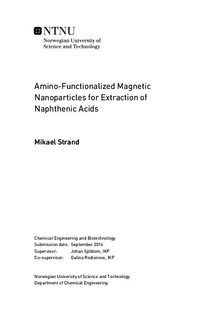| dc.description.abstract | The present work is a part of a 2-year Post Doc project carried out by a Vista program funded by Statoil and conducted in close collaboration with The Norwegian Academy of Science and Letters. The goal of the main project is to establish new methods for both preventing formation and facilitating removal of naphthenic acids (NA). The newly developed methods will be based on the application of functionalized magnetic nanoparticles (FMN) for extraction of NA before formation of the metal naphthenates as well as their removal to avoid deposit formation.
The current Master s thesis is aiming for synthesis of magnetic naked (Fe3O4), silica-coated (Fe3O4/SiO2) and amino-functionalized (Fe3O4/SiO2 NH2/C18) nanoparticles, and their application for extraction of NA from a model oil.
As a first step, commercial silica particles with known amino group (-NH2) grafting degree were purchased and tested to confirm the amino groups selectivity towards NA in a real crude oil. The oil used was an acidic sample from the Heidrun field in the North Sea. The total acid number (TAN) was measured before and after addition of the particles, and the result revealed a reduction of 92.2 % in crude oil acidity.
The Fe3O4/SiO2 NH2/C18 nanoparticles were obtained through synthesis by two different methods, a high-pressure autoclave experiment with toluene as solvent and a reflux experiment using xylene as solvent, which has a higher boiling point. The particles were tested with respect to various parameters and exhibited magnetic properties. A specific surface area of 113 m2/g was measured for the Fe3O4/SiO2 particles, while a reduction was registered for the functionalized samples. Elemental analysis revealed that 3-aminopropyltrimethoxysilane (APTMS) groups had been successfully grafted onto the surface, n-octadecyltriethoxysilane (ODS) had been grafted to a far lesser degree or not grafted at all. The electron microscopy revealed the magnetic core and silica coating of the separate particles as well as particle agglomerates. The average particle size and coating thickness were calculated based of a size distribution analysis. The two functionalization methods revealed similar results for the adsorption of model NA onto the particle surface. The amino-functionalized Fe3O4/SiO2 NH2/C18 samples showed about 2.5 to 2.9 times higher adsorption capacity of 4-heptylbenzoic acid in octane compared to the silica-coated Fe3O4/SiO2 particles from Master s thesis of Mia Ronader [1]. | |

